

The WELL. The Whole Earth 'Lectronic Link, normally shortened to The WELL, is one of the oldest virtual communities in continuous operation.

As of June 2012, it had 2,693 members.[2] It is best known for its Internet forums, but also provides email, shell accounts, and web pages. The discussion and topics on the WELL range from deeply serious to trivial, depending on the nature and interests of the participants. History[edit] 8-Circuit Model of Consciousness. The eight-circuit model of consciousness is a theory proposed by Timothy Leary and expanded on by Robert Anton Wilson and Antero Alli.

The model describes eight circuits of information (eight "brains") that operate within the human nervous system. Each circuit is concerned with a different sphere of activity. Leary, Alli and Wilson have written about the model in depth and how each circuit operates, both in the lives of individual people and in societies.
The term "circuits" came from the first wave of cybernetics research and development in the United States in the 1970s. (Others[weasel words] have proposed that the term "systems" should be substituted for "circuits" to reflect both a systems theory approach and also the changing anatomy of an entity as it goes through a neurological change). Akashic records. Background[edit] Akasha is a Sanskrit word meaning "sky", "space" or "aether", and it entered the language of theosophy through H.
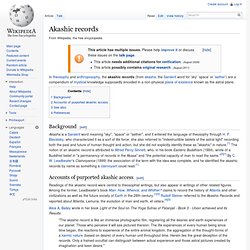
P. Blavatsky, who characterized it as a sort of life force; she also referred to "indestructible tablets of the astral light" recording both the past and future of human thought and action, but she did not explicitly identify these as "akashic" in nature.[1] The notion of an akashic record is attributed to Alfred Percy Sinnett, who, in his book Esoteric Buddhism (1884), wrote of a Buddhist belief in "a permanency of records in the Akasa" and "the potential capacity of man to read the same.
Boogiepop Phantom. Brain–computer interface. A brain–computer interface (BCI), sometimes called a mind-machine interface (MMI), direct neural interface (DNI), synthetic telepathy interface (STI) or brain–machine interface (BMI), is a direct communication pathway between the brain and an external device.
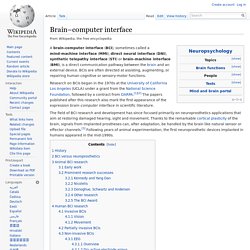
BCIs are often directed at assisting, augmenting, or repairing human cognitive or sensory-motor functions. Research on BCIs began in the 1970s at the University of California Los Angeles (UCLA) under a grant from the National Science Foundation, followed by a contract from DARPA.[1][2] The papers published after this research also mark the first appearance of the expression brain–computer interface in scientific literature. The field of BCI research and development has since focused primarily on neuroprosthetics applications that aim at restoring damaged hearing, sight and movement.
History[edit] Carl Jung. Carl Gustav Jung (/jʊŋ/; German: [ˈkarl ˈɡʊstaf jʊŋ]; 26 July 1875 – 6 June 1961), often referred to as C.

G. Jung, was a Swiss psychiatrist and psychotherapist who founded analytical psychology.[2] Collective unconscious. Collective unconscious is a term of analytical psychology, coined by Carl Jung.
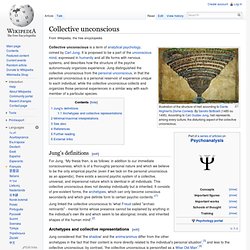
Deus ex machina. Deus ex machina (pronounced [ˈdeus eks ˈmaː.kʰi.na], /ˈdeɪ.əs ɛks ˈmɑːkiːnə/ or /ˈdiːəs ɛks ˈmækɨnə/[1]; from Latin, meaning "god from the machine"; plural: dei ex machina) is a plot device whereby a seemingly unsolvable problem is suddenly and abruptly resolved by the contrived and unexpected intervention of some new event, character, ability or object.
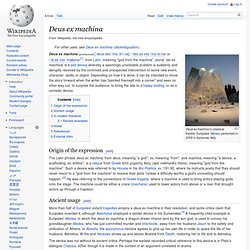
Douglas Rushkoff. Douglas Rushkoff (born 18 February 1961) is an American media theorist, writer, columnist, lecturer, graphic novelist, and documentarian.
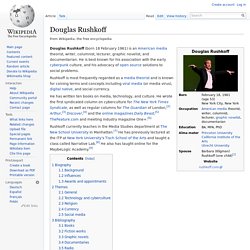
He is best known for his association with the early cyberpunk culture, and his advocacy of open source solutions to social problems. Rushkoff is most frequently regarded as a media theorist and is known for coining terms and concepts including viral media (or media virus), digital native, and social currency. Rushkoff currently teaches in the Media Studies department at The New School University in Manhattan.[7] He has previously lectured at the ITP at New York University’s Tisch School of the Arts and taught a class called Narrative Lab.[8] He also has taught online for the MaybeLogic Academy.[9] Biography[edit] Background[edit] Earth's magnetic field. Computer simulation of the Earth's field in a period of normal polarity between reversals.[1] The lines represent magnetic field lines, blue when the field points towards the center and yellow when away.
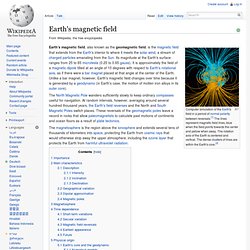
The rotation axis of the Earth is centered and vertical. The dense clusters of lines are within the Earth's core.[2] The North Magnetic Pole wanders sufficiently slowly to keep ordinary compasses useful for navigation. At random intervals, however, averaging around several hundred thousand years, the Earth's field reverses and the North and South Magnetic Poles switch places. Electrical grid. General layout of electricity networks.

Voltages and depictions of electrical lines are typical for Germany and other European systems. An electrical grid (also referred to as an electricity grid or electric grid) is an interconnected network for delivering electricity from suppliers to consumers. It consists of generating stations that produce electrical power, high-voltage transmission lines that carry power from distant sources to demand centers, and distribution lines that connect individual customers.[1] Power stations may be located near a fuel source, at a dam site, or to take advantage of renewable energy sources, and are often located away from heavily populated areas.
They are usually quite large to take advantage of the economies of scale. Extremely low frequency. 1982 aerial view of the U.S. Navy Clam Lake, Wisconsin ELF transmitter facility, used to communicate with deeply submerged submarines. Extremely low frequency (ELF) is the ITU designation[1] for electromagnetic radiation (radio waves) with frequencies from 3 to 30 Hz, and corresponding wavelengths from 100,000 to 10,000 kilometers.[2][3] In atmospheric science, an alternative definition is usually given, from 3 Hz to 3 kHz.[4][5] In the related magnetosphere science, the lower frequency electromagnetic oscillations (pulsations occurring below ~3 Hz) are considered to lie in the ULF range, which is thus also defined differently from the ITU radio bands.
Alternate definitions[edit] Military communications[edit] Instrumentality of Mankind. In the science fiction of Cordwainer Smith, the Instrumentality of Mankind refers both to Smith's personal future history and universe and to the central government of humanity. The Instrumentality of Mankind is also the title of a paperback collection of short stories by Cordwainer Smith published in 1979 (now superseded by the later The Rediscovery of Man, which collects all of Smith's short stories). Origin and history[edit] John C. Lilly. John Cunningham Lilly (January 6, 1915 – September 30, 2001) was a American physician, neuroscientist, psychoanalyst, psychonaut, philosopher, writer and inventor. He was a researcher of the nature of consciousness using mainly isolation tanks,[1] dolphin communication, and psychedelic drugs, sometimes in combination.
Early life and education[edit] John Lilly was born to a wealthy family on January 6, 1915, in Saint Paul, Minnesota. His father was Richard Coyle Lilly, president of the First National Bank of St. Kabbalah. Majestic 12. In UFO conspiracy theories, Majestic 12 (or MJ-12) is the code name of an alleged secret committee of scientists, military leaders, and government officials, formed in 1947 by an executive order by U.S. President Harry S. Truman to facilitate recovery and investigation of alien spacecraft. The concept originated in a series of supposedly leaked secret government documents first circulated by ufologists in 1984.
Upon examination, the Federal Bureau of Investigation (FBI) declared the documents to be "completely bogus", and many ufologists consider them to be an elaborate hoax.[1][2] Majestic 12 remains popular among some UFO conspiracy theorists and the concept has appeared in popular culture including television, film and literature. History and analysis[edit] Project Xanadu. Roswell UFO incident. Coordinates: The Roswell UFO incident took place in the U.S. in June or July 1947, when an airborne object crashed on a ranch near Roswell, New Mexico. Explanations of what took place are based on both official and unofficial communications. Although the crash is attributed to a secret U.S. military Air Force surveillance balloon by the U.S. government,[1] the most famous explanation of what occurred is that the object was a spacecraft containing extraterrestrial life.
Schumann resonances. Animation of Schumann resonance in Earth's atmosphere. Serial Experiments Lain. Serial Experiments Lain (シリアルエクスペリメンツレイン Shiriaru Ekusuperimentsu Rein), is an anime series directed by Ryutaro Nakamura, original character design by Yoshitoshi ABe, screenplay written by Chiaki J. Konaka, and produced by Yasuyuki Ueda (credited as production 2nd) for Triangle Staff. It was broadcast on TV Tokyo from July to September 1998. Simulated reality. Simulated reality is the hypothesis that reality could be simulated—for example by computer simulation—to a degree indistinguishable from "true" reality. It could contain conscious minds which may or may not be fully aware that they are living inside a simulation. Ted Nelson. Biography[edit]
The Rediscovery of Man. The Rediscovery of Man: The Complete Short Science Fiction of Cordwainer Smith (ISBN 0-915368-56-0) is a 1993 book containing the complete collected short fiction of science fiction author Cordwainer Smith. Timothy Leary. Vannevar Bush. Vannevar Bush (/væˈniːvɑr/ van-NEE-var; March 11, 1890 – June 28, 1974) was an American engineer, inventor and science administrator, whose most important contribution was as head of the U.S.